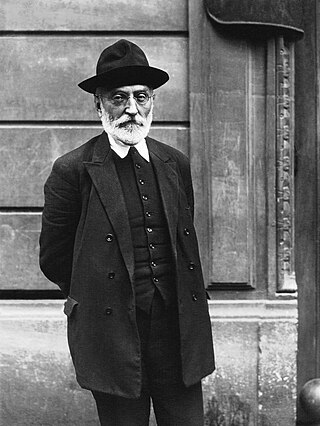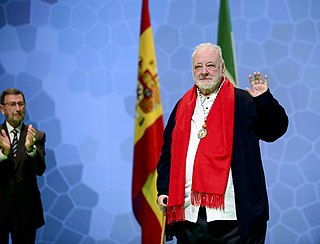
Miguel de Unamuno y Jugo was a Spanish essayist, novelist, poet, playwright, philosopher, professor of Greek and Classics, and later rector at the University of Salamanca.

Spanish literature generally refers to literature written in the Spanish language within the territory that presently constitutes the Kingdom of Spain. Its development coincides and frequently intersects with that of other literary traditions from regions within the same territory, particularly Catalan literature, Galician intersects as well with Latin, Jewish, and Arabic literary traditions of the Iberian peninsula. The literature of Spanish America is an important branch of Spanish literature, with its own particular characteristics dating back to the earliest years of Spain’s conquest of the Americas.

Benito Pérez Galdós was a Spanish realist novelist. He was the leading literary figure in 19th-century Spain, and some scholars consider him second only to Miguel de Cervantes in stature as a Spanish novelist.

Mist is a novel written by Miguel de Unamuno in 1907 and first published in 1914 by Editorial Renacimiento.

Camilo Castelo Branco, 1st Viscount of Correia Botelho, was a prolific Portuguese writer of the 19th century, having produced over 260 books. His writing is considered original in that it combines the dramatic and sentimental spirit of Romanticism with a highly personal combination of sarcasm, bitterness and dark humour. He is also celebrated for his peculiar wit and anecdotal character, as well as for his turbulent life.
Literature of the 19th century refers to world literature produced during the 19th century. The range of years is, for the purpose of this article, literature written from (roughly) 1799 to 1900. Many of the developments in literature in this period parallel changes in the visual arts and other aspects of 19th-century culture.
Latin American literature consists of the oral and written literature of Latin America in several languages, particularly in Spanish, Portuguese, and the indigenous languages of the Americas. It rose to particular prominence globally during the second half of the 20th century, largely due to the international success of the style known as magical realism. As such, the region's literature is often associated solely with this style, with the 20th century literary movement known as Latin American Boom, and with its most famous exponent, Gabriel García Márquez. Latin American literature has a rich and complex tradition of literary production that dates back many centuries.

Francisco López Acebal was a Spanish novelist, playwright and journalist.
Spanish Realist literature is the literature written in Spain during the second half of the 19th century, following the Realist movement which predominated in Europe.
San Manuel Bueno, mártir (1931) is a short novel by Miguel de Unamuno (1864–1936). It experiments with changes of narrator as well as minimalism of action and of description, and as such has been described as a nivola, a literary genre invented by Unamuno to describe his work. Its plot centers on the life of a parish priest in a small Spanish village. It was written in a period of two months at the end of 1930 along with two other stories, and was included on the Index Librorum Prohibitorum. The possibility that they may form a trilogy in three significant parts, or "partos" (births) as Unamuno suggested in the Prologue to the 1933 edition, has only recently been considered.
Angelino Fons Fernández, was a Spanish film director and screenwriter. He is known for his debut film La busca (1966). His career was closely linked to literature, adapting classic Spanish novels to the big screen.

Novelas ejemplares is a series of twelve novellas that follow the model established in Italy. The series was written by Miguel de Cervantes between 1590 and 1612 and printed in Madrid in 1613 by Juan de la Cuesta. Novelas ejemplares followed the publication of the first part of Don Quixote. The novelas were well received.

Germán Gullón, literary critic and writer, is a professor of Spanish literature and member of the Amsterdam School for Cultural Analysis at the University of Amsterdam. He has authored, beside his scholarly works and essays, two books of short stories, Adiós, Helena de Troya and Azulete, and two novels, Querida hija and La codicia de Guillermo de Orange.

Miguel Picazo de Dios was a Spanish film director, screenwriter and actor. He is best known for his first feature film La tía Tula(Aunt Tula) (1964).

Iris M. Zavala was a Puerto Rican author, scholar, and poet, who later lived in Barcelona, Spain. She had over 50 works to her name, plus hundreds of articles, dissertations, and conferences and many of her writings, including "Nocturna, mas no funesta", build on and express this belief.

Luis Coloma Roldán (1851–1915) was a Spanish writer, journalist and Jesuit. He is most known for creating the character of El Ratoncito Pérez. Coloma was a prolific writer of short stories and his complete works, which includes his novels, biographies, and other works, have since been collected in a multi-volume set. He studied at the University of Seville, where he graduated with a master's degree in law, although he never got to practice law. In 1908 Coloma became a member of the Royal Spanish Academy occupying seat "f".

Manuel Sánchez Cuesta is philosopher, ethicist and humanist.

On March 21, 1890, at a conference dedicated to the siege of Bilbao during the Third Carlist War, Miguel de Unamuno delivered a lecture titled La última guerra carlista como materia poética. It was probably the first-ever attempt to examine the Carlist motive in literature, as for the previous 57 years the subject had been increasingly present in poetry, drama and novel. However, it remains paradoxical that when Unamuno was offering his analysis, the period of great Carlist role in letters was just about to begin. It lasted for some quarter of a century, as until the late 1910s Carlism remained a key theme of numerous monumental works of Spanish literature. Afterward, it lost its appeal as a literary motive, still later reduced to instrumental role during Francoism. Today it enjoys some popularity, though no longer as catalyst of paramount cultural or political discourse; its role is mostly to provide exotic, historical, romantic, and sometimes mysterious setting.
Mercedes Castro Díaz is a Spanish writer.

Peace in War is a mid-size novel by Miguel de Unamuno. Written since the mid-1880s, it was published in 1897. The narrative is set mostly in Bilbao and surroundings during the Spanish civil war of 1872-1876, with particular focus on the siege of the city in 1874. The protagonists are mostly Bilbao dwellers, some of Carlist and some of Liberal political preferences. The plot revolves around the fate of Ignacio, a man in his early 20s, who volunteered to Carlist troops. The book was generally well received by the press and the critics, but it failed to make a major impact and was not re-published until 1923. Issued in Latin America in the 1910s, in the inter-war period the novel was translated into some major European languages, and afterwards into most European languages.